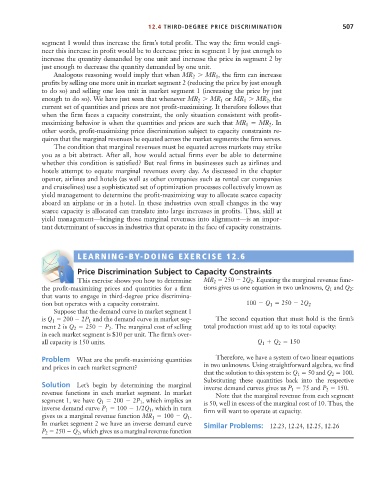Page 533 - Microeconomics, Fourth Edition
P. 533
c12capturingsurplus.qxd 7/22/10 10:41 AM Page 507
12.4 THIRD-DEGREE PRICE DISCRIMINATION 507
segment 1 would thus increase the firm’s total profit. The way the firm would engi-
neer this increase in profit would be to decrease price in segment 1 by just enough to
increase the quantity demanded by one unit and increase the price in segment 2 by
just enough to decrease the quantity demanded by one unit.
Analogous reasoning would imply that when MR 2 MR , the firm can increase
1
profits by selling one more unit in market segment 2 (reducing the price by just enough
to do so) and selling one less unit in market segment 1 (increasing the price by just
enough to do so). We have just seen that whenever MR MR or MR MR , the
1
2
1
2
current set of quantities and prices are not profit-maximizing. It therefore follows that
when the firm faces a capacity constraint, the only situation consistent with profit-
maximizing behavior is when the quantities and prices are such that MR MR . In
1
2
other words, profit-maximizing price discrimination subject to capacity constraints re-
quires that the marginal revenues be equated across the market segments the firm serves.
The condition that marginal revenues must be equated across markets may strike
you as a bit abstract. After all, how would actual firms ever be able to determine
whether this condition is satisfied? But real firms in businesses such as airlines and
hotels attempt to equate marginal revenues every day. As discussed in the chapter
opener, airlines and hotels (as well as other companies such as rental car companies
and cruiselines) use a sophisticated set of optimization processes collectively known as
yield management to determine the profit-maximizing way to allocate scarce capacity
aboard an airplane or in a hotel. In these industries even small changes in the way
scarce capacity is allocated can translate into large increases in profits. Thus, skill at
yield management—bringing those marginal revenues into alignment—is an impor-
tant determinant of success in industries that operate in the face of capacity constraints.
LEARNING-BY-DOING EXERCISE 12.6
S
D
E
Price Discrimination Subject to Capacity Constraints
This exercise shows you how to determine MR 2 250 2Q 2 . Equating the marginal revenue func-
the profit-maximizing prices and quantities for a firm tions gives us one equation in two unknowns, Q 1 and Q 2 :
that wants to engage in third-degree price discrimina-
tion but operates with a capacity constraint. 100 Q 1 250 2Q 2
Suppose that the demand curve in market segment 1
is Q 1 200 2P 1 and the demand curve in market seg- The second equation that must hold is the firm’s
ment 2 is Q 2 250 P 2 . The marginal cost of selling total production must add up to its total capacity:
in each market segment is $10 per unit. The firm’s over-
all capacity is 150 units. Q 1 Q 2 150
Problem What are the profit-maximizing quantities Therefore, we have a system of two linear equations
and prices in each market segment? in two unknowns. Using straightforward algebra, we find
that the solution to this system is: Q 1 50 and Q 2 100.
Substituting these quantities back into the respective
Solution Let’s begin by determining the marginal inverse demand curves gives us P 1 75 and P 2 150.
revenue functions in each market segment. In market Note that the marginal revenue from each segment
segment 1, we have Q 1 200 2P 1 , which implies an is 50, well in excess of the marginal cost of 10. Thus, the
inverse demand curve P 1 100 1/2Q 1 , which in turn firm will want to operate at capacity.
gives us a marginal revenue function MR 1 100 Q 1 .
In market segment 2 we have an inverse demand curve Similar Problems: 12.23, 12.24, 12.25, 12.26
P 2 250 Q 2 , which gives us a marginal revenue function

